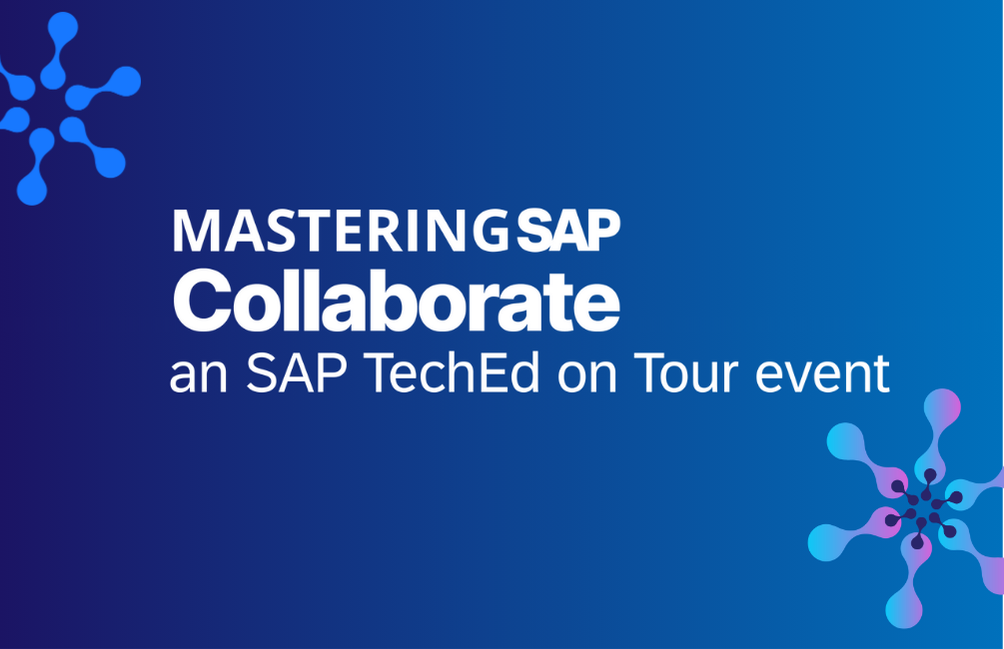SAP Architecture
Filter By
Browse By
- SAP Analytics and AI
- SAP Application Development and Integration
- All SAP Application Development and Integration
- SAP ABAP
- SAP ABAP Development Tools
- SAP ABAP Test Cockpit
- SAP API Management
- SAP BAPI
- SAP Basis
- SAP BRF
- SAP Business Application Studio
- SAP CMS
- SAP Design Studio
- SAP Development Tools
- SAP DevOps
- SAP EAI
- SAP EDI
- SAP Extension Suite
- SAP Fiori
- SAP Fiori Elements
- SAP Integration Suite
- SAP Low Code Application Development
- SAP Low Code Automation
- SAP Netweaver
- SAP Release Management
- SAP UI5
- SAP Web Application Server
- SAP Web IDE
- SAP Business Process Management
- SAP Center of Excellence
- SAP CIO
- SAP Customer Experience
- SAP Data and Data Management
- All SAP Data and Data Management
- SAP BW
- SAP BW/4HANA
- SAP Crystal Reporting
- SAP Data Archiving
- SAP Data Center
- SAP Data Governance
- SAP Data Integration
- SAP Data Migration
- SAP Data Quality
- SAP Data Services
- SAP Data Strategy
- SAP Data Visualization
- SAP Data Warehouse Cloud
- SAP DMS
- SAP Document Control
- SAP EIM
- SAP ETL
- SAP ETL Tools
- SAP HANA
- SAP HANA Administration
- SAP HANA Deployment Infrastructure
- SAP HANA Studio
- SAP Master Data
- SAP Master Data Governance
- SAP MDM
- SAP Enterprise Architect
- SAP Enterprise Asset Management
- SAP ERP
- SAP Finance
- All SAP Finance
- SAP Accounting
- SAP AR AP
- SAP Asset Accounting
- SAP Billing Systems
- SAP BPC
- SAP BRIM
- SAP Cash Management
- SAP Central Finance
- SAP Controlling
- SAP COPA
- SAP Cost Center Accounting
- SAP e-invoicing
- SAP FICO
- SAP Finance Automation
- SAP Financial Closing Cockpit
- SAP Financial Consolidation
- SAP Financial Planning
- SAP FX Risk
- SAP General Ledger
- SAP Global Tax Management
- SAP Hyperion
- SAP Order to Cash
- SAP Payment Processing
- SAP Profitability Analysis
- SAP Rebate Management
- SAP S/4HANA Finance
- SAP Universal Journal
- SAP Governance Risk and Compliance
- SAP Human Capital Management
- SAP Intelligent Technologies
- SAP Platform and Technology
- All SAP Platform and Technology
- SAP Business Technology Platform
- SAP Cloud Connector
- SAP Cloud Integration Platform
- SAP Cloud Migration
- SAP Cloud Platform
- SAP Cloud Providers
- SAP Cloud Strategy
- SAP Container Platform
- SAP Digital Asset Management
- SAP Digital Integration Hub
- SAP Digital Signature
- SAP HANA Enterprise Cloud
- SAP HEC
- SAP Hyperscalers
- SAP Infrastructure
- SAP Messaging
- SAP Smart Forms
- SAP Quality and Testing
- SAP Security
- SAP Spend Management
- SAP Supply Chain Management
- All SAP Supply Chain Management
- SAP APO
- SAP Asset Management
- SAP Business Network
- SAP Digital Manufacturing Cloud
- SAP Digital Twin
- SAP EWM
- SAP IBP
- SAP Inventory Management
- SAP Label Printing
- SAP Logistics
- SAP Manufacturing
- SAP Manufacturing Automation
- SAP MES
- SAP MII
- SAP MM
- SAP MRO
- SAP MRP
- SAP Order Management
- SAP Plant Maintenance
- SAP PLM
- SAP Production Planning
- SAP S&OP
- SAP SD
- SAP SPM
- SAP Supply Chain Planning
- SAP Track and Trace
- SAP Transportation Management
- SAP System Administration
What is SAP Architecture?
SAP Architecture is the technical requirements of your system landscape and the applications that you need for that. SAP’s major step forward in architecture came when it introduced SAP R/3 — the three references a three-layer architecture — in the late 1990s. SAP ERP applications ever since, including SAP S/4HANA, still follow these basic architectural layers:
- The Presentation Layer is the component specialized in interacting with end-users, the user interface. SAP GUI is the traditional SAP interface, but newer SAP applications utilize SAP Fiori design principles.
- The Application Layer is the component that specializes in processing the SAP application — such as SAP S/4HANA. Development at the SAP application layer has been done traditionally with the ABAP coding language. The HTML5-based UI5 is growing in importance as a language for building applications that can run on a variety of devices.
- The Database Layer is the software component that specializes in the management, storage, and retrieval of data. The key difference in SAP S/4HANA vs. previous ERPs at this level is a simplified data model that is specifically designed to run on the SAP HANA in-memory database.
What is SAP Architecture?
SAP Architecture is the technical requirements of your system landscape and the applications that you need for that. SAP’s major step forward in architecture came when it introduced SAP R/3 — the three references a three-layer architecture — in the late 1990s. SAP ERP applications ever since, including SAP S/4HANA, still follow these basic architectural layers:
- The Presentation Layer is the component specialized in interacting with end-users, the user interface. SAP GUI is the traditional SAP interface, but newer SAP applications utilize SAP Fiori design principles.
- The Application Layer is the component that specializes in processing the SAP application — such as SAP S/4HANA. Development at the SAP application layer has been done traditionally with the ABAP coding language. The HTML5-based UI5 is growing in importance as a language for building applications that can run on a variety of devices.
- The Database Layer is the software component that specializes in the management, storage, and retrieval of data. The key difference in SAP S/4HANA vs. previous ERPs at this level is a simplified data model that is specifically designed to run on the SAP HANA in-memory database.
There’s a wide range of vendors that support at least part of the SAP Architecture. Red Hat and SUSE specialize in the Linux operating system, on which the SAP HANA database runs. SAP architecture needs a foundation, and a vendor such as Dell Technologies can provide on-premise hardware such as servers. Microsoft is one of the hyperscalers that can set up cloud environments for SAP applications. Companies like Deloitte offer consulting services to assist companies in building out their SAP Architecture.
Key Considerations for SAPinsiders:
- ABAP coders are still important to SAP Architecture. If your company is looking to adopt SAP S/4HANA and other SAP applications with consumer-grade user experiences, then you will likely need UI5 and SAP Fiori skillsets.
- Legacy SAP ERP systems typically have heavy customization at the application layer and potentially complex data models. Many customers that are adopting SAP S/4HANA are choosing to eschew customization and instead are adapting their processes to the technology to provide cleaner data and easier upgrades.
- SAP HANA’s in-memory capabilities are meant to speed up data retrieval significantly. However, with the rise of low-cost and open-source data storage, many companies are storing their data in “hot” and “cold” locations. Hot, or frequently accessed, data may be stored in-memory, but cold, or sporadically accessed, data may be stored in a Hadoop Distributed File System (HDFS) or cloud storage.
936 results
-

SAP S/4HANA on Your Own Terms: Shaping the Right Migration Strategy
August 27, 2025
With SAP ECC support ending soon, many organisations are under pressure to plan a well-informed transition to SAP S/4HANA. While Brownfield and Greenfield remain the traditional approaches, a third path called Selective Data Transition (SDT) is increasingly being considered, particularly for businesses with complex system landscapes. This approach is supported by Enterprise Transformer, a software developed…
-

Get the Most Out of SAPSprint for Server-Based Printing in Microsoft Windows
Published: 22/April/2009
Reading time: 19 mins
SAPSprint is the latest service for server-based printing on Windows. Learn how to install and configure this service with its default options. Drill down into the technical implementation to learn how to manage print requests, restart print processes, configure front-end printing, and include barcodes. Key Concept Processing in SAPSprint means generating print data via the...…
-

Selective Data Transition vs. Full Migration: Choosing the Right Approach for SAP S/4HANA
Reading time: 17 mins
Migrating from SAP ECC to SAP S/4HANA involves choosing between Selective Data Transition, which allows for flexible and tailored data migration, and Full Migration, which fully integrates existing systems but requires significant reconfiguration, with specific strategies and thorough preparations critical for successful execution.
-
-

How to Select the Right Mobile Solution Architecture for Your Use Case
Published: 12/October/2012
Reading time: 24 mins
Understand the main mobility architecture paradigms currently supported by the Sybase Unwired Platform, and the advantages and drawbacks of each. Get a high-level view of the architecture and basic steps for implementing each. Key Concept A mobile business object is a method of encapsulating business data so that it can be used across multiple kinds...…
-

Technical Considerations for Executing an SAPUI5 Project
Published: 05/April/2016
Reading time: 22 mins
Follow these best practices and tips outlined by Ameya Pimpalgaonkar if you are planning to execute an SAPUI5 project. See how an SAPUI5 project differs from a traditional project and why the design process is essential if you want to avoid technical errors. Key Concept It is essential that all SAPUI5 projects begin with a...…
-

SAP HANA Administration Chat: Kurt Hollis on Architecture, Monitoring, and More
Published: 01/January/2017
Reading time: 40 mins
SAP HANA is an in-memory database engine and application platform that offers unique advantages for reporting and high-performance operations. Customers have to answer many questions in their path to running on SAP HANA. How can architect your SAP HANA solution to fit your needs? Once you are up and running, how can administrators monitor the…
-

Configure SAPSprint for Secure Server-Based Printing on Windows
Published: 17/June/2009
Reading time: 146 mins
You can have as wide and varied a range of printing needs as you have business needs. Learn about the available SAPSprint options — what they are and what they do — so you can help your organization meet its specific printing needs. Key Concept Secure Network Communications (SNC) integrates an external security product with...…
-
-

Understanding Your SAP System Architecture Before Migrating to the Cloud
Published: 12/June/2020
Reading time: 11 mins
Before migrating your existing SAP systems to the cloud—an initiative that many businesses are undertaking to remain relevant and redefine their IT landscape—it’s important that SAP customers understand their system architecture. Knowing where the connection points are between different pieces of architecture, where you’re putting them from an infrastructure perspective, and what sort of information…
-

Lessons Learned from an SAP HANA Cloud Platform Implementation
Published: 06/December/2016
Reading time: 19 mins
Key principles and facts are included in this overview of the design and implementation of a cloud application on SAP HANA Cloud Platform. Key Concept Applications consume and expose web service application program interfaces (APIs) that facilitate the re-usability of the capabilities of an application and support the integration into other applications. The following solution...…
-

From Complexity to Intelligence: Scaling Enterprise AI with SAP Business AI, SAP Databricks, and DXC Technology
Published: 14/March/2025
Reading time: 6 mins
This article discusses how DXC Technology leverages over 30 years of partnership with SAP to help enterprises effectively implement and scale AI solutions, such as SAP Business AI and SAP Databricks, overcoming challenges like data silos and governance issues to drive significant business transformation.
Become a Member
Unlimited access to thousands of resources for SAP-specific expertise that can only be found here.
Upcoming Events
-

Mastering SAP Collaborate an SAP TechEd on Tour event
November 12 - 14, 2025
Sydney, New South Wales
Australia
View Event
Your request has been successfully sent